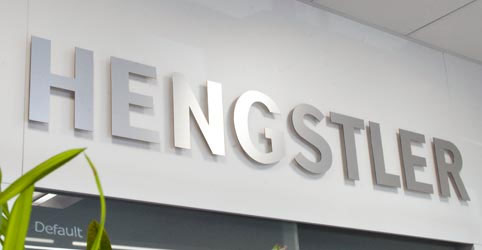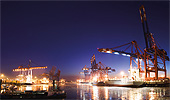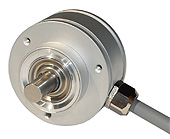
Cost efficiency and high productivity are significantly increasing in today’s offshore and marine applications. It doesn’t matter if we refer to applications in the O&G market, wind energy, boats and ships or equipment for docks and piers. The level of automation is increasing rapidly. Simultaneously the need for safety and reliability gains attention, especially in harsh environments where systems are exposed to rough weather conditions and sea water.
As a rule, marine products and equipment used in offshore applications are supposed to be either water-resistant or water-proof and corrosion-resistant. There are several standards and regulations controlled by authorities helping equipment builders to choose the right product providing certificates in specific classifications.
Hengstler offers with the robust AR-series, rotative encoders to meet such demanding environments. Its design is resistant to tough climate environments with high temperature fluctuations, high mechanical stress like vibrations and shock and resistant to influences through aggressive sea water.
With the DNV certification for maritime approval the compact AR-series has been complemented to offer best in class solutions for offshore and maritime applications.
There are many different types of marine products and marine equipment, like shipboard equipment, cargo equipment, and safety equipment. It includes winches, anchors, hoisting and lowering equipment, or ship propelling and steering systems. The need of automation through all those applications can be met by the usage of encoders that measure position and speed efficiently and very precisely. In most of those applications reliability is extraordinary important to avoid any downtime of the system related to failures of components. This could quickly grow to several times the cost of the system itself. Therefore equipment builder many times are forced to implement expensive redundant or over-dimensioned systems.

A typical example for encoder applications in ships and vessels is propelling and steering. Encoders are used in thrusters and propellers to feedback the exact position for precise manoeuvring and stabilization. Vessels are highly capital-intensive assets and require maximum operation uptime and therewith highest reliability. Usually components like encoders are replaced during the regular service intervals, only. Therefor the systems are equipped with redundant components keeping the system alive in case of malfunction.
Other applications for encoders can be found in cargo equipment like highly automated cranes and booms, which are controlled remotely to be operated even during rough weather conditions avoiding any people being injured during operations. Again, high exact positioning and speed control is needed at highest reliability. This is managed by appropriate encoders mounted on various axes of the boom to measure the position or on winches for speed and layer control.
In wind applications encoders are used on the service vessels as described before and on the wind mills themselves. The encoder controls the position of the pitches by making sure the blades are always in the optimal position to have maximum efficiency at lowest risk for the equipment. Being offshore means a very corrosive atmosphere requiring specific material for the components to be resistant to sea water and high temperature changes.
There are many encoder types on the market with different technologies. All of them can be very precise and work properly for a period of time. However, depending on the environmental conditions like temperature cycles, shock and vibration, salty water and humidity, industrial encoders are most likely to fail after short time in such environments. Industrial encoders are mainly composed of a highly precise glass disc mounted on a shaft, an an optical system to detect the position or speed and a geared system for the multiturn detection. This requires many moving mechanical parts which are sensitive to over-stressed and potentially fail during operation.

Heavy duty encoders ideally offer more robust technologies, avoiding moving parts such as gears, glass disc or sensitive components like batteries. A fully magnetic and electronic technology provides the necessary mechanical robustness and reliability. Combined with over-dimensioned bearings mechanical loads of more than 300N can be achieved radially and axially. The protection class is important to prevent water or humidity leaking into the devices causing malfunction of the electronic. IP67 might be sufficient in many applications, but IP69k offers protection even for applications where the encoder is emerged in water. For maritime environments the choice of the right material is crucial as well. Corrosive seawater is very aggressive; therefore specific materials like seawater resistant aluminium or stainless steel should be used for the housing.
Hengstler encoders like the AR-series have been designed specifically for such demanding applications and have been certified by DNV with the maritime certificate. This approval classifies materials, components and systems relevant to safe operation and quality. Very severe tests are performed to ensure the systems and components are fit for their purpose. As part of the certification the components need to pass mechanical, electrical and climatic tests. This includes continuous shock and vibration tests, protection class tests by immersing the encoders in water to a depth of 1m or exposing to sprayed salt mist. For electromagnetic compatibility the components are tested on EMC immunity and emission as well as electrostatic discharge.
The right choice of components helps to offer maximum personal safety, as well as high efficiency and long uptimes for equipment operating under harsh offshore and maritime conditions. It pays off rapidly by providing reliable and safe operations of the systems.